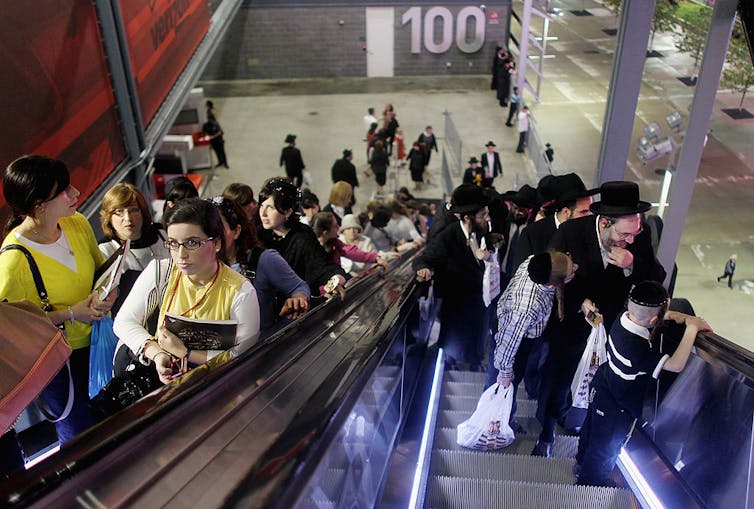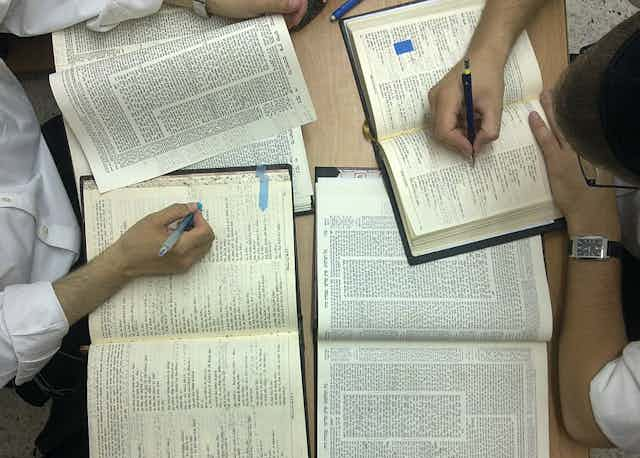“Genderqueer” and “nonbinary” are contemporary terms for people who don’t fit neatly into male or female categories. But acknowledging that not everyone fits neatly into those two groups has a much longer history than you might suspect.
As a scholar of Judaism and gender, I find that people across the political spectrum often assume religion must be inherently conservative and unchanging when it comes to sex and gender. They imagine that religions have always embraced a world in which there are only men and women.
But for Judaism – and for many other religious traditions, too – history shows that’s just not true.
More than two terms
Traditional Jewish sources discuss the categories “man” and “woman,” but these aren’t the only designations rabbinic texts use for sex and gender.
Rabbinic literature, the body of texts written by Jewish leaders in antiquity, includes several other categories. In these texts, a person with both sets of external genitalia is called an “androgynos,” a term borrowed from Greek. A person with neither is called a “tumtum,” and a person who loses his male sexual organs is called a “saris.” There is also a term for someone whose sex assigned at birth is female but does not develop to female sexual maturity – in some cases, because they develop “male” traits: an “aylonit.”
For example, Genesis Rabbah, a collection of creative Biblical interpretation from late antiquity, records an interpretation of a creation story in the biblical book of Genesis in which God forms the first humans. Genesis 1 includes the phrase, “Male and female He created them,” which many readers interpret to mean that God created a man and a woman.
But some of the rabbis quoted in Genesis Rabbah believed that God had made an androgynos.
One rabbi explained: “In the hour when the Holy One Blessed Be He created the first human, He created an androgynos, as it is written, ‘male and female He created them.’”
Genesis Rabbah continues with another rabbi’s argument that God made the first human with two fronts: a female face and body facing one way, and a male face and body facing the opposite direction. Only later did God split the two, in this rabbi’s reading.
Though the specifics of their interpretations differ, both put an androgynos at the center of God’s creation.
Applying the law
Jewish law, or halakhah, is based on a gender binary. For example, some commandments, such as studying Torah or not shaving sidelocks, apply only to men; others, such as Sabbath candle lighting, apply only to women.
However, some halakhic traditions also recognize that not every person’s body fits that binary.

The Mishnah, a text compiled in the third century C.E. which includes halakhic material, roots its interpretations in the categories men and women, yet also affirms the idea that sex and gender go beyond those terms.
For example, a section called Mishnah Bikkurim explains: “There are some ways the androgynos is like men, and some ways he is like women, and some ways he is like men and women, and some ways he is like neither men nor women.” Another section of the Mishnah explains that, like women, neither a tumtum nor an androgynos is obligated to go to the Temple in Jerusalem as part of certain religious festivals. Meanwhile, an androgynos must dress like a man, and a priest cannot marry an aylonit unless he already has children.
As these examples suggest, gender diversity is woven throughout rabbinic traditions. Yet there is still a hierarchy, with men holding positions of the highest religious obligation.
It is also important to note how these categories differ from the ways people understand gender today. A nonbinary person in the 21st century does not have the same experience as a tumtum in late antiquity. The idea of “aylonit” does not map clearly onto any common gender identity today. Even the term “androgynos” is not quite the same as intersex. And none of the rabbinic categories match current ideas about trans identity.
Forging a future
In spite of this textual tradition, many observant Jewish communities today still tend toward a gender binary. In most Orthodox synagogues, for example, a physical partition divides the worship space into two sections: one for men and one for women. Halakhic rulings about whether and how parents should support medical interventions on intersex children suggest they should be raised as male or female, not as an androgynos or tumtum.
In other Jewish communal spaces, however, traditional texts have become a resource for contemporary LGBTQ+ Jews. Some look to these texts to affirm their beliefs that Judaism has always seen gender diversity as a spectrum. Others use these texts to see themselves within Jewish tradition. Still others use these examples to call for change in the present, countering anti-LGBTQ+ positions.

Many of these Jews recognize that the diversity of sex and gender in these ancient texts is different from gender identity today, but they believe the past can still serve as an important tool in the present.
Rabbinic texts illustrate that there is no magical time in the past when every person fit easily and naturally into gender categories.

